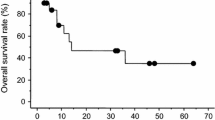Abstract
Purpose: Only 20–30% of patient with advanced germ cell tumors, relapsing after standard first-line therapy, are curable with current second-line cisplatin-based regimens. New salvage combinations incorporating new active agents are needed. We report the toxicity/tolerance of a new salvage regimen based on the oxaliplatin (Eloxatin)/cisplatin combination, evaluated in patients with recurrent, mostly cisplatin-refractory germ cell tumors. Patients and methods: Thirteen patients were enrolled in this study. All except one had received cisplatin-based chemotherapy. Eight had progressive disease as the best response on their last platinum-based chemotherapy, and three had potentially sensitive tumors. The median interval since the last platinum-based chemotherapy was 6 months (range: 1–36 months). One untreated patient with poor prognosis was also enrolled. Twelve patients had pathological markers [median α-fetoprotein 14 800 ng/ml (58–106), median human chorionic gonadotrophin β subunit 7000 IU/ml (37–723 700)]. Patients received either oxaliplatin (130 mg/m2) and cisplatin (100 mg/m2) every 3–4 weeks (Bi regimen, four patients), or the same regimen combined with one to four of the following cytotoxic agents: ifosfamide, epirubicin, vinorelbine, methotrexate, dactinomycin, etoposide and bleomycin (BiC regimen, 9 patients). Treatment was individualized according to each individual patient's pretreatment and clinical characteristics. Results: Seven objective responses were obtained (overall response rate = 54%), all with the BiC regimens (two complete and five partial responses). Two patients with recurrent disease achieved a long-term complete response lasting over 5 years. Four partial responders were seen in the eight cisplatin-refractory tumors, lasting 4–8 months. All objective responses had a corroborating major decrease in tumor marker blood levels (median decrease: 99.7%). The median survival for the whole group was 8 months. The commonest severe toxicity was hematological (grade 4 neutropenia in 78% and thrombopenia in 74% of the BiC cycles). Conclusion: Our combined salvage regimen induced significant antitumoral activity in recurrent, cisplatin-refractory germ cell tumors. Oxaliplatin merits further evaluation as a component of combination therapy for this disease.
Similar content being viewed by others
Author information
Authors and Affiliations
Additional information
Received: 12 February 1999 / Accepted: 28 June 1999
Rights and permissions
About this article
Cite this article
Soulié, P., Garrino, C., Bensmaïne, M. et al. Antitumoral activity of oxaliplatin/cisplatin-based combination therapy in cisplatin-refractory germ cell cancer patients. J Cancer Res Clin Oncol 125, 707–711 (1999). https://doi.org/10.1007/s004320050338
Issue Date:
DOI: https://doi.org/10.1007/s004320050338




